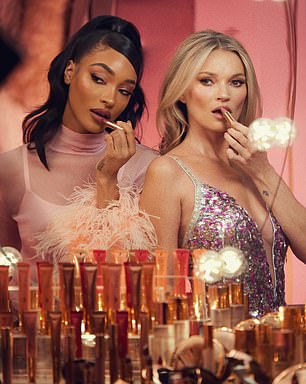Glamorous: Jourdan Dunn and Kate Moss apply Charlotte Tilbury lipstick
Cosmetics and skincare stocks should be an easy way to spruce up a portfolio.
After all, these companies are players in a £230bn high-margin global market whose products are persuasively promoted in social media tutorials.
But there is talk of a slowdown in the sector, whose pricing power has been the envy of other companies. As a result, investors looking to ‘zhuzh’ (beauty tutorial to ‘give a boost’) to their holdings will be paying close attention to the upcoming listing of Puig, the Spanish owner of British glamor brand Charlotte Tilbury.
Puig, a family business, could be worth up to £12bn when it debuts next month on the Madrid stock exchange, highlighting demand for make-up and creams from a growing demographic in Europe and elsewhere.
As Rathbone’s David Coombs points out, skin cancer awareness means more men are using moisturizers, representing a lasting structural change in the industry.
Meanwhile, “tweens,” customers about to enter adolescence, constitute a well-informed and rapidly expanding clientele, shopping for themselves and encouraging their mothers to spend. You can witness this phenomenon in the aisles of Sephora, which is part of the top-performing division of luxury goods giant LVMH.
Sephora has more expensive lines, such as Rare Beauty, the range founded by American actress Selena Gomez, as well as ‘viral dupes’ that offer looks for less.
However, the outlook suddenly seems uncertain, despite the popularity of Charlotte Tilbury and rumors surrounding newer products such as Bum Bum cream from Sol de Janeiro, a subsidiary of Occitane.
Analysts at brokerage Bernstein estimate that growth in the US this year could be just 7 percent, down from 15 percent in 2023.
This has caused shares of L’Oreal, Ulta Beauty, an American chain, and Estee Lauder to fall. This group has been reeling from supply chain problems in China, although its diverse offering includes trendy Le Labo perfumes and Clinique creams.
Companies like ELF (eyes, lips, face) have also been affected by the more nervous mood.
The stock is down 15 percent this month, though up 1,348 percent in five years thanks to its affordable options or alternatives.
Do these declines suggest that the lipstick index thesis (that spending on lipstick and other “slaps” increases during difficult times) is no longer relevant?

The index was devised by Leonard Lauder, the group’s president during the recession of the early 1990s.
Or have Estée Lauder’s problems influenced the perception of the entire sector?
Fundsmith manager Terry Smith divested the fund’s stake in Estee Lauder earlier this year. However, he still owns LVMH and also L’Oreal, allowing the fund’s investors (like me) exposure to brands like Lancome and Tween favorite CeraVe.
Coombs also took advantage of the drop in Ulta Beauty shares to increase his fund holdings.
He points to Ulta’s strengths, including online sales and the social aspect of a visit to its stores located in shopping centers with parking.
In this context, I bet that buyers of all ages will continue to enjoy lipsticks and creams to limit aging and sun damage.
I’ve invested some money in Britain’s biggest boot retailer: Boots, the 175-year-old company, part of the US-based Walgreens Boots Alliance.
Rumors that its parent company will create a spin-off from Boots may have died down. But the chain recently reported a 15 percent rebound in sales, helped by the clamor for Sol de Janeiro and the Shiseido Drunk Elephant brand.
This name will make you laugh or suggest that the innovation in this sector is such that it is worth taking a gamble.

